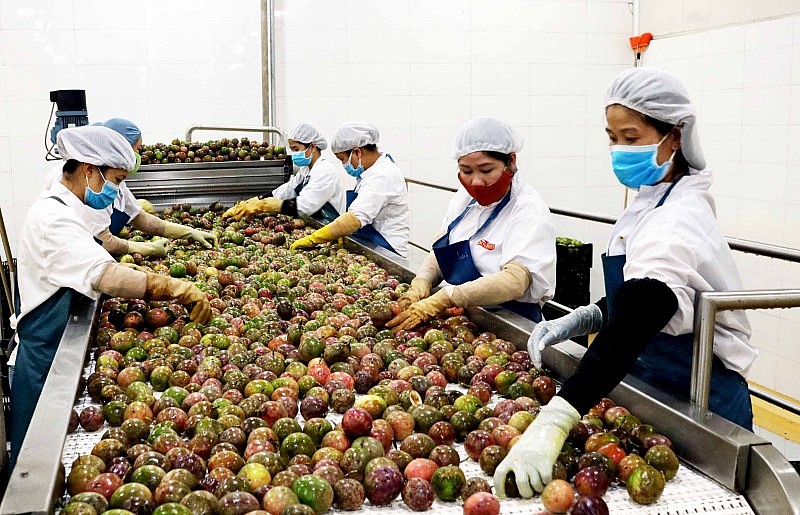 News
News
EVFTA AGREEMENT FRIDAY, NOVEMBER 18, 2022 - 14:07 Follow Congthuong.vn on
| Two years of implementation of the EVFTA Agreement: The EU market is changing very stronglyEVFTA Agreement: Opportunities for food and beverage businesses to access the EU market |
The market space is still very large
At the seminar "Increasing the presence of Vietnamese enterprises exporting to the EU" organized by Industry and Trade Magazine on the morning of November 18, Mr. Ngo Chung Khanh, Deputy Director, Department of Multilateral Trade Policy - Ministry of Industry and Trade said. In general, the EU market is quite diverse. This is a market with high purchasing power, a large potential market and especially when there is a potential and effective FTA like EVFTA , the EU becomes a very attractive market for Vietnamese businesses.
 |
However, Mr. Ngo Chung Khanh also shared frankly, because Europeans' thinking, both in the negotiation process or in the implementation process, has a feature that they are not only interested in product prices. , not only care about quality but also care about how products are made, or how businesses treat workers, the environment, and society. This is a feature that many Vietnamese businesses know, but not all businesses are ready to prepare for.
After two years of implementation, the EVFTA has brought positive results, but it must be admitted that there is still a lot of room. Specifically, the market share of many of our strategic products such as seafood and vegetables is our strength, but the market share is still very low. In which, more than 2-3% of vegetables and fruits, more than 4% of seafood, and only 4% of apparel.
“The second point is that our business is still outsourcing a lot. Some enterprises in recent years have been noted to have focused on processing and improving product quality such as Dong Dao Company, Loc Troi rice, Vinh Hiep coffee, Khuong Sinh pepper... This is a driving force. It is very good for Vietnamese businesses to increase their presence with their brand, with their values. But it is a bit unfortunate that the number of such brands is still quite modest," said Mr. Ngo Chung Khanh.
Ms. Nguyen Thi Thu Trang, Director of the Center for WTO and Integration - VCCI added that the EU is our traditional export market. About ten years ago, the EU was Vietnam's second largest export market, now it is Vietnam's third largest export market after the United States and China. The EU is also a market where we have had relatively good growth so far.
In the first two years of implementing the EVFTA, Vietnam's export turnover averaged about $41.7 billion a year and was higher than the annual average of the 2016-2019 period ($33.5 billion), 24 % (equivalent to higher than 1/4).
However, if we look from the perspective of what we have not done, in terms of the proportion of the EU market in Vietnam's total export turnover, about 10 years ago somewhere around 19% - 20% but then gradually decreased and by 2021, the proportion was only about 12%. Obviously, although the turnover has increased, the growth rate of Vietnam's exports to the EU market is lower than the growth rate of Vietnam's exports to all world markets and this is also reflected in the increase in turnover. Vietnam's turnover to the EU is always lower than the average growth rate of Vietnam's exports to the world market.
According to a survey by VCCI, the biggest reason for this situation is that many businesses have never had any transactions with the EU market, so they do not benefit from this agreement.
The second group of problems mentioned is that businesses do not know what benefits from EVFTA will be.
In addition, in the current context, the EU is particularly emphasizing environmental standards, humanities standards, etc., labor issues, CBAM tax (carbon tax) to meet EU standards is not only a matter of concern. The challenge is for businesses that have never exported to the EU, but it is also a challenge for those who are familiar with the experience in the EU, because standards are changing and requirements are higher.
In addition, according to a survey by VCCI, the factor that hinders businesses from taking advantage of opportunities from free trade agreements in general and the EVFTA, in addition to the biggest factor is market fluctuations and uncertainty. It is also the limited competitiveness of enterprises.
 |
| The potential of Vietnamese vegetables and fruits in the EU is still very large |
From a business perspective, Mr. Dinh Cao Khue, Chairman of the Board of Directors - General Director, Dong Giao Foodstuff Export Joint Stock Company (DOVECO), Vice Chairman of the Vietnam Fruit and Vegetables Association said that the reason why businesses determine The European market is a traditional market, the first is that the EU's import residue is very large. In the world with 8 billion people, the EU is about 500 million people, but import demand accounts for about 45% of the world's demand for vegetables and fruits. This is in great demand.
The second problem, for EU countries in particular and European countries in general, they cannot grow tropical fruits and vegetables such as pineapple, banana, passion fruit...
Another thing for Europe is fair and serious payments. This is a very favorable thing for businesses.
However, in fact, Europe is a highly demanding market in terms of both quantity and quality. At the same time, they are particularly interested in how businesses use workers and what the factory landscape looks like. This is a difficult requirement, but if done step by step, businesses can meet the requirements of EU countries in particular and Europe in general.
Join hands to bring products into the EU market
To better present goods in the EU market, Ms. Nguyen Thi Thu Trang said, it is necessary to do better trade promotion activities by switching from trade promotion for businesses' products to trade promotion. for an entire industry. As for the connection work, currently, a number of Vietnamese deals are doing a good job of this connection and have initially brought very positive results. This is a form that should continue to be expanded so that many other businesses can benefit.
Or in the story of supporting Vietnamese businesses to overcome technical barriers or food safety and hygiene, quality requirements, the state can support businesses to check products, so that businesses can ensure their goods are safe and export to your market without being returned. Or training for businesses to know how the EU process requires businesses to respond, businesses on that basis will comply to be able to access the market.
From a business perspective, Mr. Dinh Cao Khue said: "In order for businesses to compete, not only in the EU and domestic markets, Japan, Korea and the US markets, the nature of enterprises must have competitiveness".
To do this, businesses must do two things well, first, the quality of goods must be good. Second is the reasonable price.
In addition, businesses need the support of authorities in promoting products through fairs because this is still the most basic approach. There are many approaches such as e-commerce , Facebook… but fair is still the most basic approach.
“Therefore, a leading agency like the Ministry of Industry and Trade needs to organize businesses in a more methodical way, from decoration, support to design, to booths. Because each fair, a company can only have 4-6 square meters, not enough decoration space, not enough space to do... still not good. There should be national or industry pavilions on a larger scale. Because the company's products are not inferior to other countries' - Mr. Khue said.
For businesses, Mr. Khue said, it is necessary to invest in large production to be able to apply scientific and technical measures, from pest control, to care and especially to increase labor productivity and reduce labor costs. prices to increase competition.
Another problem is to form a chain of links from farmers, cooperatives to traders to ensure product quality and standards.